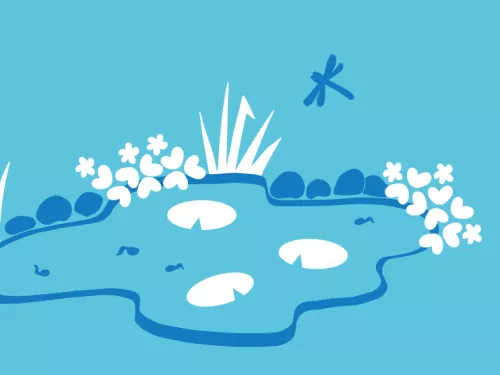A bog garden can be created by adapting an existing soggy area, or from scratch, either at the edge of a pond, or as a standalone feature. Permanently damp, it creates an area where moisture-loving plants thrive. These plants are different to those suited to the standing water of a pond, so will attract a host of different wildlife.
A bog garden may be a better option than a pond for families with young children. Like a pond, it should attract frogs, toads and even grass snakes. Dragonflies and damselflies will perch on the taller grasses, and bees and butterflies will flit around the flowers.
Planning your bog garden
- Decide on size. Lay out a length of rope or hose to help you to work out the size of your bog garden. Beware of making it very large, though, as it will be harder to maintain and stepping stones may be required.
- Research your plants. Unlike pond plants, bog plants thrive in soil with high nutrient levels and that contain lots of organic matter. There is a huge range of exciting bog plants, from creeping jenny to tiny water forget-me-nots. A little research will reveal their partialities, for instance, whether they are sun- or shade-loving, the degree of damp and acidity preferred, and the amount of space they require.
Establishing your bog garden
- Pick a spot. Making an artificial bog is very like making a pond. Pick a spot on level ground, away from overhanging trees.
- Dig a hole. Dig a hole about 30 cm (12 in) deep.
- Lay a butyl liner in the hole. Make a few drainage slits in the liner and return the excavated soil, mixed with some organic material, to the hole.
- Water the soil thoroughly. Try to use rainwater, especially if the soil is acidic. If tap water is the only means of filling, let it stand for a few days to allow any additives to break down.
- Leave the soil to settle for about a week before planting up.
Maintaining your bog garden
- Plant a combination of short and tall plants for cover and perches.
- Be careful what you plant as some species can be vigorous, aggressive or very large, such as pendulous sedge and gunnera.
- Think about planting so that there is a range of flowers throughout the year, from marsh-marigold in spring, to hemp-agrimony in autumn.
- Water your bog in drought, but respect hosepipe bans. Try to use rainwater if you can.
- Include stepping stones if you bog garden is very big. This will help you to get to the plants as you maintain them without compacting the soil.
Top tips
- If you’re digging your bog garden into turf, place the sods grass-side down around its edge for an instant, nutrient-rich planting medium.
- If a bog garden’s not possible, a miniature version can be created in a container, and planted up. This will probably dry out quicker than a traditional bog garden, so will need topping up with water frequently.
- ‘Palustris’ and ‘ulignosus’ mean ‘bog’ or ‘marsh’ in Latin, so look out for these words in the names of plants, for example, Caltha palustris. It shows that they are appropriate for this environment.
Suggested species:





